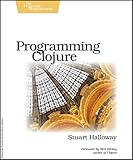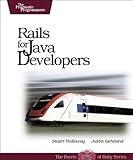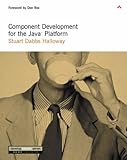Stuart Halloway
President of Cognitect
Stuart Halloway is a founder and President of Cognitect, Inc. (www.cognitect.com). He is a Clojure committer, and a developer of the Datomic database.Stuart has spoken at a variety of industry events, including StrangeLoop, Clojure/conj, EuroClojure, ClojureWest, SpeakerConf, QCon, GOTO, OSCON, RailsConf, RubyConf, JavaOne, and NFJS.
Stuart has written a number of books and technical articles. Of these, he is most proud of Programming Clojure.
Learn more about Stu's presentations on his wiki.
Presentations
edn and Fressian: Flexible Languages for Data
8:30 PM MDT
edn and Fressian are self-describing, schema-free, batteries-included, extensible data languages. In this talk, you will find out where you might benefit from these languages over e.g. JSON or XML.
Systems use many languages, and not just programming languages such as Java, C#, Ruby, or Python. Systems also relay on data languages, both for data on the wire, and for data at rest. These data languages differ greatly in their design objectives and capabilities, and are often less understood than their programming language counterparts.
This talk will introduce two data notations: edn and Fressian, which share several common characteristics. Both are
- self-describing
- schema-free
- batteries-included
- extensible
These capabilities align well with the dynamic, flexible needs of real systems. And in their key difference (text vs. binary), edn and Fressian cover the bases of human readability and maximum performance.
Pure Fun
7:30 PM MDT
No business objectives will be accomplished during this talk.
The purpose of “Pure Fun” is to participate in the sheer joy of using computers. Each talk is an individual performance where you might see or participate in some of the following:
- Exploring music with SuperCollider and Overtone
- Flying an A/R drone helicopter
- Controlling a robot
- Developing a core wars game
- Visualizing data from ridiculous sources
Generative Testing
9:00 AM MDT
Traditional automated testing approches combine input generation, execution, output capture, and validation inside the bodies of single functions. Generative testing approaches gain expressive power by isolating these steps.
With generative testing:
- a generator is a declarative description of possible inputs to a function
- execution is up to your program
- outputs are data, and can be captured for future study
- validators are programs that have access to the generators, the program, and the outputs
There are a number of benefits to this approach:
- once test data generation is separate, it is immediately obvious that such data generation should be statistical, not merely a few hand-picked cases
- validators can be reused in a variety of
- it becomes easier to identify and develop declarative, logic-based validations, rather than imperative ones
- the various phases can be decoupled and run at different times
This talk introduces test data generation and generative testing, using for its examples the data.generators and test.generative libraries developed by the author.
Resources
- test.generative
- data.generators
- chapter 10 of Programming Clojure
Simulation Testing with Simulant
10:45 AM MDT
Simulation allows a rigorous, scalable, and reproducible approach to testing. The separation of concerns, and the use of a versioned, time-aware database, give simulation great power. This talk will introduce simulation testing, walking through a complete example using Simulant, an open-source simulation library.
Simulation allows a rigorous, scalable, and reproducible approach to testing:
Statistical modeling
Simulation begins with statistical models of the use of your system. This model includes facts such as “we have identified four customer profiles, each with different browsing and purchasing patterns” or “the analytics query for the management report must run every Wednesday afternoon.” Models are versioned and kept in a database.
Activity streams
The statistical models are used to create activity streams. Each agent in the system represents a human user or external process interacting with the system, and has its own timestamped stream of interactions. With a large number of agents, simulations can produce the highly concurrent activity expected in a large production system.
Distributed execution
Agents are scaled across as many machines as are necessary to both handle the simulation load, and give access to the system under test. The simulator coordinates time, playing through the activity streams for all the agents.
Result Capture
Every step of the simulation process, including modeling, activity stream generation, execution, and the code itself, is captured and stored in a database for further analysis. You will typically also capture whatever logs and metrics your system produces.
Validation
Since all phases of a simulation are kept in a database, validation can be performed at any time. This differs markedly from many approaches to testing, which require in-the-moment validation against the live system.
Separation of concerns
The separation of concerns above, and the use of a versioned, time-aware database, gives simulation great power. Imagine that you get a bug report from the field, and you realize that the bug corresponds to a corner case that you failed to consider. With a simulation-based approach, you can write a new validation for the corner case, and run that validation against your past simulation results, without ever running your actual system.
This talk will introduce simulation testing, walking through a complete example using Simulant, an open-source simulation library.
Introduction to Clojure
1:30 PM MDT
Clojure is a powerful dynamic language that compiles to many target environments, including the JVM, JavaScript, and the CLR. In this talk, you will learn how to think in Clojure, and why you should want to.
Clojure encourages functional style with persistent data structures, a rich library of pure functions, and powerful processing support via the seq and reducer abstractions. Clojure implements a reference model for state, where references represent atomic successions of values, and change is encapsulated by value and reference constructors. This reference model is more substantive and suitable to application development than individual techniques such as Software Transactional Memory (STM) or actors.
The most important single principle behind Clojure is simplicity. Clojure's abstractions are simple and orthogonal. A la carte polymorphism, careful support for names and namespaces, the reference succession model, and a wide selection of small, composable protocols make Clojure programming swift, surgical and accurate.
Clojure's expressiveness does not mean that you have to compromise on power. It is an explicit design goal of Clojure to provide access to the power of the underlying platform, and for programmers never to have to “drop down” to the platform level for performance-sensitive work.
On the Web
- Programming Clojure by Stuart Halloway and Aaron Bedra
Introduction to Clojure
3:15 PM MDT
Clojure is a powerful dynamic language that compiles to many target environments, including the JVM, JavaScript, and the CLR. In this talk, you will learn how to think in Clojure, and why you should want to.
Clojure encourages functional style with persistent data structures, a rich library of pure functions, and powerful processing support via the seq and reducer abstractions. Clojure implements a reference model for state, where references represent atomic successions of values, and change is encapsulated by value and reference constructors. This reference model is more substantive and suitable to application development than individual techniques such as Software Transactional Memory (STM) or actors.
The most important single principle behind Clojure is simplicity. Clojure's abstractions are simple and orthogonal. A la carte polymorphism, careful support for names and namespaces, the reference succession model, and a wide selection of small, composable protocols make Clojure programming swift, surgical and accurate.
Clojure's expressiveness does not mean that you have to compromise on power. It is an explicit design goal of Clojure to provide access to the power of the underlying platform, and for programmers never to have to “drop down” to the platform level for performance-sensitive work.
On the Web
- Programming Clojure by Stuart Halloway and Aaron Bedra
Books
Programming Clojure
by Stuart Halloway and Aaron Bedra
If you want to keep up with the significant changes in this important language, you need the second edition of Programming Clojure. Stu and Aaron describe the modifications to the numerics system in Clojure 1.3, explain new Clojure concepts such as Protocols and Datatypes, and teach you how to think in Clojure.
Programming Clojure, 2nd Edition is a significant update to the classic book on the Clojure language. You'll get thorough coverage of all the new features of Clojure 1.3, and enjoy reorganized and rewritten chapters that reflect the significance of new Clojure concepts. Many code examples have been rewritten or replaced, and every page has been reevaluated in the light of Clojure 1.3.
As Aaron and Stu show you how to build an application from scratch, you'll get a rich view into a complete Clojure workflow. And you'll get an invaluable education in thinking in Clojure as you work out solutions to the various parts of a problem.
Clojure is becoming the language of choice for many who are moving to functional programming or dealing with the challenges of concurrency. Clojure offers:
The simplicity of an elegantly designed language
The power of Lisp
The virtues of concurrency and functional style
The reach of the JVM
The speed of hand-written Java code
It's the combination of these features that makes Clojure sparkle. Programming Clojure, 2nd Edition shows you how to think in Clojure, and to take advantage of these combined strengths to build powerful programs quickly.
What You Need:
Oracle JDK 6
A text editor
Programming Clojure (Pragmatic Programmers)
by Stuart Halloway
Clojure is a dynamic language for the Java Virtual Machine, with a compelling combination of features:
Clojure is elegant. Clojure's clean, careful design lets you write programs that get right to the essence of a problem, without a lot of clutter and ceremony.
Clojure is Lisp reloaded. Clojure has the power inherent in Lisp, but is not constrained by the history of Lisp.
Clojure is a functional language. Data structures are immutable, and functions tend to be side-effect free. This makes it easier to write correct programs, and to compose large programs from smaller ones.
Clojure is concurrent. Rather than error-prone locking, Clojure provides software transactional memory.
Clojure embraces Java. Calling from Clojure to Java is direct, and goes through no translation layer.
Clojure is fast. Wherever you need it, you can get the exact same performance that you could get from hand-written Java code.
Many other languages offer some of these features, but the combination of them all makes Clojure sparkle. Programming Clojure shows you why these features are so important, and how you can use Clojure to build powerful programs quickly.
Rails for Java Developers
by Stuart Halloway and Justin Gehtland
Many Java developers are now looking at Ruby, and the Ruby on Rails web framework. If you are one of them, this book is your guide. Written by experienced developers who love both Java and Ruby, this book will show you, via detailed comparisons and commentary, how to translate your hard-earned Java knowledge and skills into the world of Ruby and Rails.
If you are a Java programmer, you shouldn't have to start at the very beginning! You already have deep experience with the design issues that inspired Rails, and can use this background to quickly learn Ruby and Rails. But Ruby looks a lot different from Java, and some of those differences support powerful abstractions that Java lacks. We'll be your guides to this new, but not strange, territory.
In each chapter, we build a series of parallel examples to demonstrate some facet of web development. Because the Rails examples sit next to Java examples, you can start this book in the middle, or anywhere else you want. You can use the Java version of the code, plus the analysis, to quickly grok what the Rails version is doing. We have carefully cross-referenced and indexed the book to facilitate jumping around as you need to.
Thanks to your background in Java, this one short book can cover a half-dozen books' worth of ideas:




